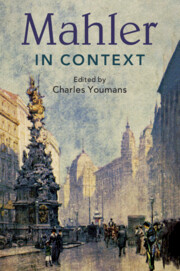Book contents
- Mahler in Context
- Composers in Context
- Mahler in Context
- Copyright page
- Dedication
- Contents
- Figures
- Music Examples
- Notes on Contributors
- Preface and Acknowledgments
- Abbreviations
- Part I Formation
- Part II Performance
- Part III Creation
- Chapter 12 The Composer “Goes to Press”
- Chapter 13 Mahler and Program Music
- Chapter 14 Intertextuality in Mahler
- Chapter 15 The Symphony, 1870–1911
- Chapter 16 Mahler and the Visual Arts of His Time
- Chapter 17 Mahler and Modernism
- Chapter 18 Reception in Vienna
- Chapter 19 Mahler’s Press from London to Los Angeles
- Part IV Mind, Body, Spirit
- Part V Influence
- Further Reading
- Index
Chapter 18 - Reception in Vienna
from Part III - Creation
Published online by Cambridge University Press: 18 December 2020
- Mahler in Context
- Composers in Context
- Mahler in Context
- Copyright page
- Dedication
- Contents
- Figures
- Music Examples
- Notes on Contributors
- Preface and Acknowledgments
- Abbreviations
- Part I Formation
- Part II Performance
- Part III Creation
- Chapter 12 The Composer “Goes to Press”
- Chapter 13 Mahler and Program Music
- Chapter 14 Intertextuality in Mahler
- Chapter 15 The Symphony, 1870–1911
- Chapter 16 Mahler and the Visual Arts of His Time
- Chapter 17 Mahler and Modernism
- Chapter 18 Reception in Vienna
- Chapter 19 Mahler’s Press from London to Los Angeles
- Part IV Mind, Body, Spirit
- Part V Influence
- Further Reading
- Index
Summary
Gustav Klimt’s Mahlerian knight in his Beethoven Frieze (1902), produced for the opening of the Secession building, represented Mahler as an allegorical, even mythical figure, building on the painter’s already a considerable reputation for allegorical paintings on topics ranging from philosophy and jurisprudence to love. A remarkable feature of Mahler reception in Vienna in the early 1900s is that so many other creative artists and intellectuals in the composer’s orbit likewise framed his impact on music or society in allegorical terms. These included figures who had known the composer personally since youth, and others who barely knew him at all, and in both groups were thinkers not otherwise prone to public displays of romantic imagining. Three main figures are considered here – the composer Arnold Schoenberg, the musicologist Guido Adler, and the critic Max Brod – who together established the generally current image of Mahler as a saint, a visionary, and a cementer and proclaimer of community.
- Type
- Chapter
- Information
- Mahler in Context , pp. 154 - 161Publisher: Cambridge University PressPrint publication year: 2020

